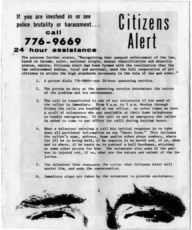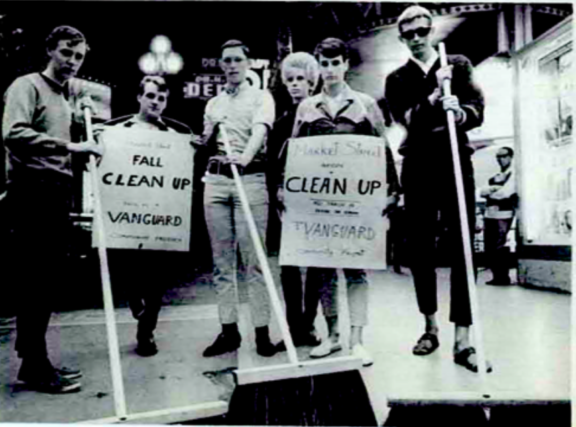From 1965 to 1967, the Tenderloin had an organization called Vanguard, composed of poor, transient, and LGBT youth. Founded by Adrian Ravarour, a Mormon priest and advocate of nonviolent resistance, it was the first gay youth liberation group in the country. “As a priest Ravarour felt obligated to enliven their hearts, souls, and minds in his personal belief that being Gay was a natural human emotion and that discrimination against the youth for being Gay was unjustified.” Glide Church, led by Cecil Williams, granted them space to organize for free, so they demonstrated outside of numerous businesses that refused to serve gay youth. The second leader, Jean-Paul Marat, in 1966, accepted Glide’s offer to sponsor them when the organization had roughly forty members. Marat was “very vocal about rights for hustlers, prostitutes and pill heads,” whereas Ravarour focused on individuals’ spiritual nature and their right to equality. Glide’s Reverend Larry Mamiya was appointed as the first Advisor to Vanguard, and he later organized the first-ever LGBT youth dance in a church, located in Glide’s basement. In response to the Compton Riot, they held a minor protest and a major picket. Marat also organized the “Street Sweep.” Keeping thee publication Vanguard magazine, the organization evolved into The Gay and Lesbian Center (1967-mid 80s).
This image is significant because it shows the gay youth community openly engaging with the media and the public eye. Their Street Sweep was their decision to prove something to the public, thereby taking their image/reputation into their own hands as poor, transient outsiders. One could argue that they were concerned with respectability and they did not need to put down Black Power, these things exposing their sense of solidarity that was more developed by cross-struggles the following decade. Still, it should not be lost that this organization was unprecedented. It is one of endless instances that shows the Tenderloin’s leadership in the gay liberation movement.

The purpose further states, “Recognizing that unequal enforcement of the law, based on income, color, national origin, sexual identification and minority status, exists, Citizens Alert has been formed with the realization that the law enforcement bodies, local and national, need the full cooperation of all citizens to attain the high standards necessary in the rule of law and order.”
- A person dials 776-9669 — our 24-hour answering service.
- The person on duty at the answering service determines the nature of the problem and its seriousness.
- The call is transferred to one of our volunteers if the need of the caller is immediate. From 9 am to 5 pm Monday through Friday the calls are handled at our office. At other times we have a staff of volunteers who are available at their home telephones to handle emergencies. If the call is not an emergency the caller is asked to come to our office (or call) during daytime hours.
- When a volunteer receives a call his initial response is to take down all pertinent information on our “short form.” This includes the caller’s name, address, home and/or phone numbers, where and to where, if he wants us to contact a bail bondsman, attorney or some other person for him. The volunteer also asks if the person is injured and, if so, what are the nature and extent of the injuries.
- The volunteer then reassures the caller that Citizens Alert will assist him, and ends the conversation.
- Immediate steps are taken by the volunteer to provide assistance.
This image shows from Vanguard shows how organizers outlined a process for their community members to seek help in times of danger. It is curious how they insist on “full cooperation” in order to facilitate the stabilization of law and order. This makes the political orientation unclear because “law and order” is what negates their existence and safety as queer street youth. Nonetheless, the group wanted to organize around having immediate, accessible assistance for those on the street.
